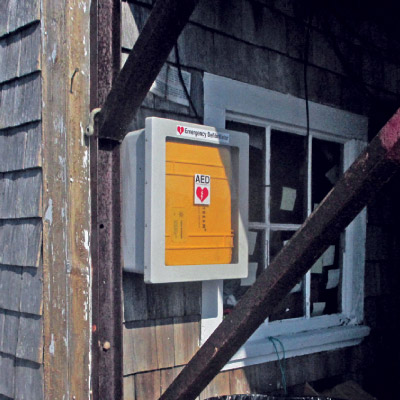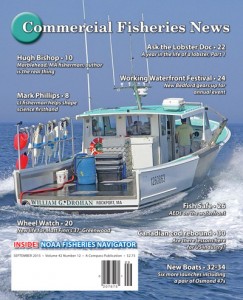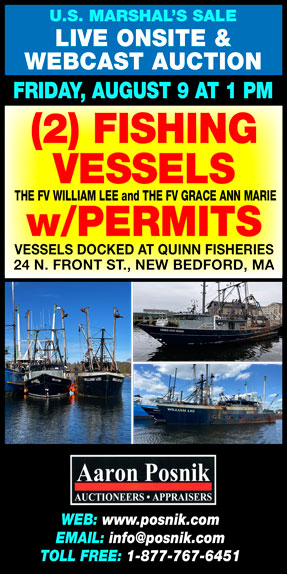Since taking my CPR/AED (cardiopulmonary resuscitation-automated external defibrillator) certification in July, I have tried to be aware of where AEDs/defibrillators are located.

The intention to look for them has to be “trained-in” as they are not as readily available or as obvious as fire extinguishers.
Yet should you need one, knowing its whereabouts could save a life.
While on vacation on the working waterfront in Friendship, ME in August, I noted the town’s 2014 annual reportmentioned locations for new AEDs at Bramhall’s Lobster Co-op, the Fishermen’s Heritage Lobster Co-op, Benner’s wharf, and at the local store – Archie’s.
I went in search of these units and found three of the four of them.
Presumably the fourth AED unit was at Benner’s wharf where it should have been, I just couldn’t locate the wharf.
As for the ones I did find – all housed in weatherproof cabinets – each unit included an informative note about the availability of training; a statement saying “anyone can operate these units” (i.e., training is not required); some basic instructions; a reminder that when one is unconscious and in cardiac arrest, quick response with an AED could save a life; and several contact numbers.
While writing this article I learned that AEDs have been placed at various locations on Southport Island near Boothbay Harbor.
If AEDs are being installed on working waterfronts throughout Maine and other states, kudos to the towns and city health officers, fire departments, ambulance teams, benefactors, etc.
If Friendship is one of a few waterfronts with AEDs, it is a good model for other working waterfronts.
Summer is probably a good time to discuss AEDs because intense work in the kind of heat that we have been experiencing can be very stressful on our hearts.
AED use
An AED is used in the case of sudden cardiac arrest (SCA) when a person’s heart has stopped beating or is beating irregularly.
People tend to shy away from thinking that a bystander can use one, but these units have been developed to be user-friendly.
To use a defibrillator when someone is unconscious or has collapsed, take the unit in its case to the person.

Know what you are looking for. These watertight boxes found on a number of Maine wharves can safe a life – your’s or a fellow fisherman’s. (Ann Backus photo)
Check the pulse and breathing, try to arouse the person by shaking him or her (don’t shake children or infants) and calling out loudly his/her name or a generic term such as “buddy, buddy.”
Meanwhile ask if anyone knows CPR, and if “yes” start CPR. Send someone else to call 911.
If breathing and/or pulse are not present or irregular, prepare to use the AED.
A waterfront location may be wet. Be sure the person is on dry ground and is dry.
Turn the AED on and follow the voice prompts and displayed instructions. Attach the two electrodes to the bare, dry chest as indicated, first removing chest hair (with the scissors) as needed and any metal such as piercings or an underwire bra (scissors again).
Work quickly.
Check for a medical alert bracelet or an implanted device such as a pacemaker.
Have all present move back, be sure the electrode wires are plugged into the AED, then press the “analyze” button.
The AED will automatically analyze the person’s heart rhythm and determine if a shock is needed.
Should a shock be needed, the AED will instruct that all stand back and not touch the patient.
At this point, press “shock” and watch the person’s response.
If a shock is not needed or if the electrodes are not correctly placed or connected, the AED voice prompt will report these circumstances.
After the shock, resume CPR until medical help arrives.
Trade off CPR responsibility to avoid fatigue.
As CPR is an important component of this process, CPR training is very helpful. Seek out a CPR/AED three-hour course this fall.
For AED instructions, visit: http://www.nhlbi.nih.gov/health/health-topics/topics/aed/howtouse.
As AED use can save the life of a person in sudden cardiac arrest (where the heart has stopped or is beating irregularly), having these units on your waterfront and in strategic places in your local area is an excellent idea.
You can collaborate with your local health department, health officer, or fire or ambulance team to obtain several units and arrange CPR/AED training.
In Friendship, the auxiliary ambulance fund paid for the units. /cfn/

If you liked this article or found it useful, please share with other fishermen!
Enjoy more FREE Safety articles HERE.
Read the rest of the September issue of Commercial Fisheries News – please choose from the following options:
• Buy a Single PRINT edition of CFN that is delivered by MAIL. PRINT EDITION
• Quickly enjoy ONLINE access with our flip-book. ONLINE EDITION
(Read online flip-book immediately with access key and download a copy for yourself. Not sure? SAMPLE HERE)
• SAVE BIG when you SUBSCRIBE!








 Updating...
Updating...